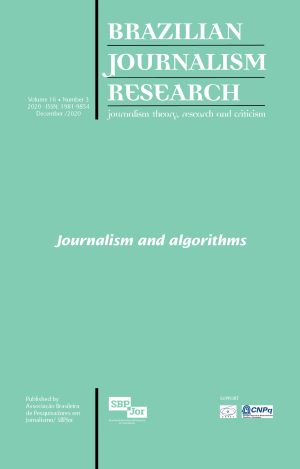Abstract
Making sense of the mutual shaping of journalism and algorithms requires research that closely analyses developments in very concrete, precise settings, but also studies that take a wider, theoretical perspective, or that put this evolution in historical context. This special issue provides this variety of points of view to contribute to the understanding of the opportunities and the challenges at the intersection between journalism and technology today.
References
Alsina, M. R. (1989). La construcción de la noticia (2a ed.). Barcelona: Paidós.
Anderson, C.W. (2013). Towards a sociology of computational and algorithmic journalism. New Media & Society, 15(7), 1005–1021. DOI: 10.1177/1461444812465137
Brin, C., Charron, J., & Bonville, J. (2004). Nature et transformations du journalisme. Théories et recherches empiriques. Québec: Les Presses de l’Université Laval.
Bucher, T. (2018). If ... Then. Algorithmic power and politics. Oxford: Oxford University Press.
Carlson, M. (2017). Journalistic authority: Legitimating news in the digital era. [s.l.] Columbia University Press.
Caswell, D. (2019). Structured Journalism and the Semantic Units of News. Digital Journalism, 7(8), 1134–1156. DOI: 10.1080/21670811.2019.1651665
Chalaby, J. (1998). The Invention of Journalism. London, MacMillan Press.
Cheney-Lippod, J. (2017). We Are Data: Algorithms and The Making of Our Digital Selves. NY: NYU Press.
Coddington, M. (2015). Clarifying journalism’s quantitative turn: A typology for evaluating data journalism, computational journalism, and computer-assisted reporting. Digital Journalism, 3(3), 331–348. DOI: 10.1080/21670811.2014.976400
Danaher, J. (2016). The Threat of Algocracy: Reality, Resistance and Accommodation. Philosophy and Technology, 29(3), 245–268. DOI: 10.1007/s13347-015-0211-1
Davis, E. (1998). Techgnosis: myth, magic + mysticism in the age of information. New York: Three Rivers Press.
Deuze, M. (2005). What is journalism? Professional identity and ideology of journalists reconsidered. Journalism 6(4), 442–464. DOI: 10.1177/1464884905056815
Deuze, M., & Witschge, T. (2017). Beyond journalism: theorizing the transformation of journalism. Journalism, 19(2), 165–182. DOI: 10.1177/1464884916688550
Diakopoulos, N. (2015). Algorithmic Accountability: Journalistic investigation of computational power structures.
Digital Journalism, 3(3), 398–415. DOI: 10.1080/21670811.2014.976411
Dörr, K. N. (2016). Mapping the field of algorithmic journalism. Digital Journalism, 4(6), 700–722. DOI: 10.1080/21670811.2015.1096748
Dourish, P. (2016). Algorithms and their others: Algorithmic culture in context. Big Data & Society, 3(2), 1–11. DOI: 10.1177/2053951716665128
Finn, E. (2017). What Algorithms Want: Imagination in the Age of Computing. Cambridge, Mass.: London – MIT.
Franciscato, C. (2005). A fabricação do presente: como o jornalismo reformulou a experiência do tempo nas sociedades ocidentais. São Cristóvão: Editora UFS/Fundação Oviedo Teixeira.
Gomis, Lorenzo. (1991). Teoría del periodismo: Cómo se forma el presente. Barcelona: Paidós.
Introna, L. D. (2016). Algorithms, governance, and governmentality on governing academic writing. Science, Technology & Human Values, 41(1), 17–49. DOI: 10.1177/0162243915587360
Gillespie, T. (2010). The politics of “platforms”. New Media & Society, 12(3), 347–364. DOI: 10.1177/1461444809342738
Lemos, A. (2020). Plataformas, dataficação e performatividade algorítmica (PDPA): Desafios atuais da cibercultura. In N. Prata, & S. C. Pessoa (Eds.), Fluxos Comunicacionais e Crise da Democracia (pp.117–126). São Paulo: Intercom.
Joux, A., & Bassoni, M. (2018). Le journalisme saisi par les Big Data? Résistances épistémologiques, ruptures économiques et adaptations professionnelles. Les Enjeux de l'information et de la communication, 19/2(2), 125–134. DOI: 10.3917/enic.025.0125
Lupton, Deborah. (2016). The Quantified Self. Malden: Polity Press.
Lewis, S. C. (2015). Journalism in an era of big data: Cases, concepts, and critiques. Digital Journalism, 3(3), 321–330.
Mayer-Schönberger, V., & Cukier, K. (2013). Big data: A revolution that will transform how we live, work, and think. Kindle ed. [s.l.] Houghton Mifflin Harcourt.
Noble, D. (1999). The religion of technology: the divinity of man and the spirit of invention. London: Penguin Books.
Park, R. E. (1955). Natural History of the Newspaper. Society – Collective Behavior, News and Opinion, Sociology and Modern Society, 29(3), 273–289. Illinois: The Free Press. Retrieved from www.jstor.org/stable/2764232?seq=1#metadata_info_tab_contents
Schudson. M. (1978). Discovering the news: a social history of American newspapers. New York: Basic Books.
Schudson. M. (1995). The Power of News. Cambridge, Massachusetts: Harvard University Press.
Schudson, M. (2007). News and democracy society: past, present and future. The Hedgejog Review, 10(2), 7–21.
Seaver, N. (2013). Knowing algorithms. Media in Transition, 8, 1–12. Retrieved from https://static1.squarespace.com/static/55eb004ee4b0518639d59d9b/t/55ece1bfe4b030b2e8302e1e/1441587647177/seaverMiT8.pdf
Sebbah, B., Sire, G., & Smyrnaios, N. (2020). Journalisme et plateformes: de la symbiose à la dépendance. Sur le journalisme, About journalism, Sobre jornalismo, 9(1), 6–11. Retrieved from www.surlejournalisme.kinghost.net/rev/index.php/slj/article/view/411
Wu, S., Tandoc Jr., E. C., & Salmon C. T. (2019). Journalism Reconfigured: Assessing human–machine relations and the autonomous power of automation in news production. Journalism Studies, 20(10), 1440-1457. DOI: 10.1080/1461670X.2018.1521299
Stefik, M. (1996). Internet dreams: archetypes, myths and metaphors. Cambridge: The MIT Press.
Van Dijck, J. (2014). Datafication, dataism and dataveillance: Big data between scientific paradigm and ideology.
Surveillance and Society, 12(2), 197–208. DOI: 10.24908/ss.v12i2.4776
Van Dijck, J., Poell, T., & Waal, M. (2018). The Platform Society. New York: Oxford University Press.
Zuboff, S. (2015). Big other: Surveillance capitalism and the prospects of an information civilization. Journal of Information Technology, 30(1), 75–89. DOI: 10.1057/jit.2015.5
Copyright for articles published in this journal is retained by the authors, with first publication rights granted to the journal. By virtue of their appearance in this open access journal, articles are free to use, with proper attribution, in educational and other non-commercial settings.
This work is licensed under a Creative Commons Attribution-NonCommercial-NoDerivatives 4.0 International License.


